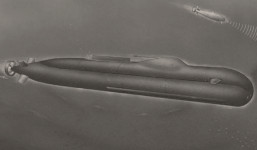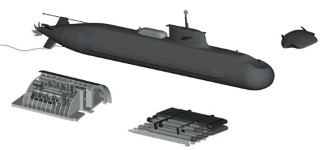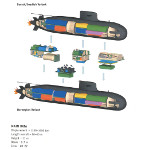Sweden_A21_Flundran_submarine
With thanks to the late Fredrik Granholm
#####
Sweden’s unique flatfish AIP attack submarine design![]()
 The A21 was a next-generation Air Independent Power (AIP – also described as Air Independent Propulsion) submarine concept from the end of the Cold War and into the 1990s as one of three designs in the Ubåt 2000 program. Its unique shape was wider than it was tall leading to the nickname ‘Flundran’ meaning flounder or flat-fish.
The A21 was a next-generation Air Independent Power (AIP – also described as Air Independent Propulsion) submarine concept from the end of the Cold War and into the 1990s as one of three designs in the Ubåt 2000 program. Its unique shape was wider than it was tall leading to the nickname ‘Flundran’ meaning flounder or flat-fish.

The Swedish design flair for submarines goes back to the 1800s. In 1886 a Swedish designed Nordenfelt-class boat was the first ever to launch a torpedo. The Swedish Navy only became serious about submarines after they were adopted by major powers however and initially used British and Italian built boats. But Sweden soon began indigenous submarine production and today has a long and rich history of innovative and cutting-edge designs suited to its specific requirements. Swedish boats tend to be smaller and better suited to the complex littoral environment of the Baltic.
Since the 1950s Sweden has had access to many cutting-edge Western submarine concepts and developments (particularly via United States Navy), and has been less conservative than many other submarine building nations in how they apply them, even if the resulting subs have tended to be compact and relatively inexpensive.
Get The essential guide to World Submarines
This Covert Shores Recognition Guide Covers over 80 classes of submarines including all types currently in service with World Navies.
Check it out on Amazon
Studies for the A19S Gotland Class successor began in 1988, eight years before the HMS Gotland entered service. The new class was expected to enter service in the mid-2000s, replacing older boats. The ‘Flounder’ design was designated A21 in the Swedish submarine taxonomy, and its more-conventional rival was labelled A22. These evolved into the final A23 ‘Ubåt 2000’ in 1990-93. Relevant designation sequence:
A19S: Gotland Class. 60 meter AIP equipped submarine, mainstay of Swedish submarine force since mid-1990s. Three built.
A20: unbuilt 1980s design study for a low-cost submarine.
A21: initial ‘Flounder’ submarine design for Ubåt 2000
A22: alternative Ubåt 2000 design with more conventional single-hull form
A23: final Ubåt 2000 design combining ideas from both A21 and A22
A24: Project Viking Nordic submarine design, Norwegian variant
A25: Project Viking Nordic submarine design, Swedish / Danish variant
A26: next generation Swedish submarine following cancellation of Ubåt 2000 and Project Viking.
This article will focus on the A21 ‘Flounder’ and design.
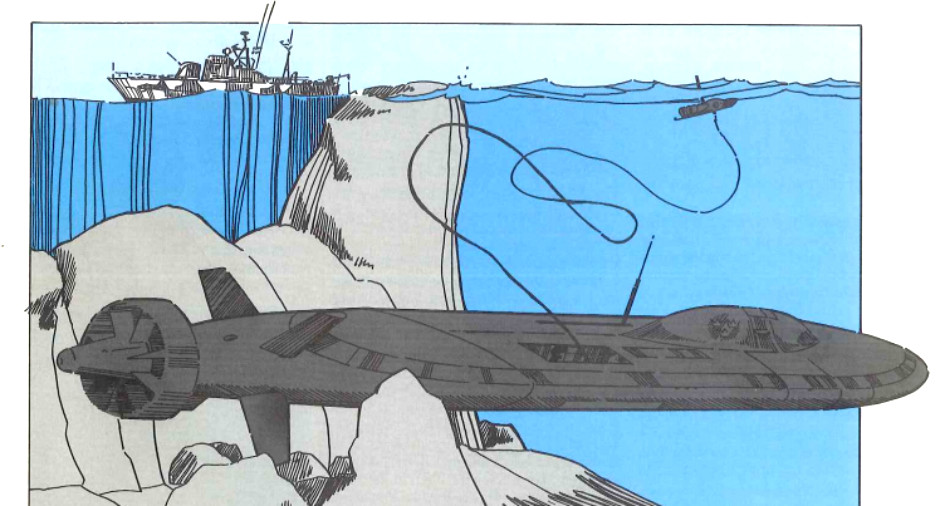
A21 illustration by Wyn Enqvist for Swedish Navy magazine Marin Nytt, 1991
Despite Sweden’s relative prosperity, there was a political requirement that the Ubåt 2000 would be around 30% cheaper than the A19 Gotland Class. There was also an expectation that the submarine would not exceed 50 meters overall. Therefore the design focus was largely on cost reduction rather than increasing overall combat effectiveness.
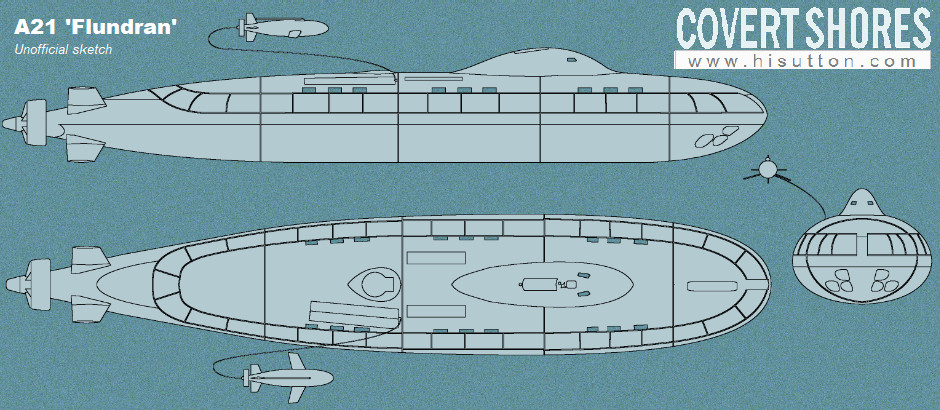
Uniquely, Ubåt 2000 was to have been a pure AIP submarine with only Stirling-generators as power source. Sweden was pioneering the modern adoption of AIP as a means of stealth and endurance on conventional submarines. By relying on them entirely, the designers eliminated the bulky diesel generator which took up around 20% of the space in other Swedish submarines. Kockums was then working on further developing their V4 Stirling into V8 and V12 configurations. The resulting boat would have been shorter ranged than a diesel-electric boat but still have useful endurance and the pre-charged batteries for burst speed if needed.
The wide double-hull allowed the Liquid Oxygen (‘LOX’) flasks to be carried externally to the main pressure hull, which combined with the absence of the diesel generator compartment allowed the significant reduction in length. The sail was also distinctive, being much smaller and more streamlined than other Swedish submarines. The shape was designed to minimize active sonar reflections and resembled the Soviet ALFA Class SSN. The sail was more or less a raised structure for the main access trunk. The lack of snort mast and adoption of a then-futuristic optronic mast allowed the small size. Additionally the optronic mast meant that the control room could be moved to the bow of the pressure hull instead of under the sail, a trend which is only now becoming normal in Western designs.
The boat appears to have had a wrap-around conformal sonar array.
Another innovative feature was a built-in hangar for a large Remotely Operated Vehicle (ROV) which would have a long cable and decent propulsion in order to act as an offboard sensor. In the complex littoral environment of the Baltic the ROV could allow the submarine to see and fire at targets on the other side of the many small islands and rocks. It could also use active sonar without compromising the stealth of the submarine to the same extent as if the boat’s own sonar was used in active mode. The concept was revolutionary at the time.
The ultimate book of Special Forces subs Covert Shores 2nd Edition is the ONLY world history of naval Special Forces, their missions and their specialist vehicles. SEALs, SBS, COMSUBIN, Sh-13, Spetsnaz, Kampfschwimmers, Commando Hubert, 4RR and many more.
Check it out on Amazon
The A22 was more conventional with the LOX tanks inside the hull, resulting in a longer boat. The sail and other internal features were similar and the ROV was carried under a raised casing.
Ultimately however computer modelling was insufficiently mature for Kockums (the Swedish shipyard responsible for submarine development, Now part of Saab) to fully validate the hydrodynamics so the more conventional A22 design won out. The Resulting A23 was still a merge of the two concepts but outwardly more like the A22.
####
The post-Cold War arms cuts and funding delays affected progress with the Ub-2000 program and it was still unbuilt when a new politically motivated program took over. The Viking project sought to build a common low-cost submarine for the Swedish, Danish and Norwegian Navies. Norwegian requirements steered it towards a much more old-fashioned boat than Ub-2000 and the resulting design can be thought of as twenty years behind. The Viking program was also still-born because Danish politicians decided to exit the submarine game in 2004. Eventually Sweden began the impressive A26 program which will finally realize some of the ideas originally developed under Ub-2000.
Related articles (Full index of popular Covert Shores articles)

 A-26 Class attack submarine. w/Cutaway
A-26 Class attack submarine. w/Cutaway

 SMX-31 future submarine concept (‘The Electric’) w/Cutaway
SMX-31 future submarine concept (‘The Electric’) w/Cutaway

 British SSN(R) next generation Royal Navy SSN
British SSN(R) next generation Royal Navy SSN

 Surcouf Cruiser Submarine w/Cutaway
Surcouf Cruiser Submarine w/Cutaway

 Project 885 ‘YASEN’ (Severodvinsk Class) SSGN. w/Cutaway
Project 885 ‘YASEN’ (Severodvinsk Class) SSGN. w/Cutaway

 Type-XXIXH stealth U-Boat. w/Cutaway
Type-XXIXH stealth U-Boat. w/Cutaway

 Project 705 ‘ALFA’ class attack submarine. w/Cutaway
Project 705 ‘ALFA’ class attack submarine. w/Cutaway

 Sweden’s nuclear powered submarine project (A-11A)
Sweden’s nuclear powered submarine project (A-11A)

 HUSKY Class future attack submarine
HUSKY Class future attack submarine















 World survey of AIP submarines
World survey of AIP submarines

 Barbel Class - the last front-line diesel boats int the US Navy
Barbel Class - the last front-line diesel boats int the US Navy






